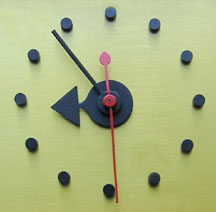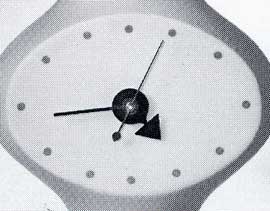Jefferson Contemporaire
By Roger Russell
These
pages are copyrighted.
No portion of this site may be reproduced in whole or in part
without written permission of the author.
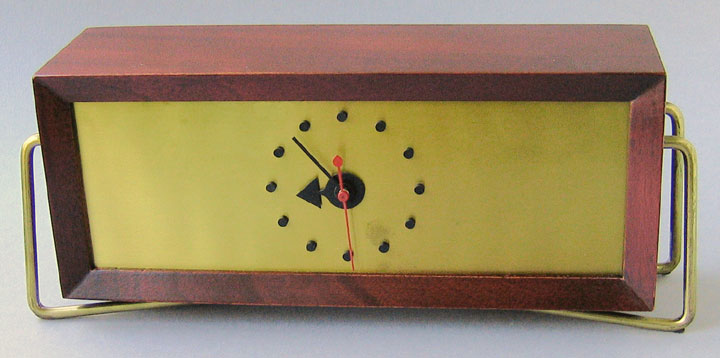
Catalog number 580-501. The Contemporaire clock is a completely different design. The case has a shiny mahogany finish. The two shaped steel rods have a gold colored finish and hold the box above the surface. Small 3/16" diameter black cylinders indicate the hours. The hour and minute hands are black and the second hand is red. A paste-on label on the bach of the clock says Jefferson Electric Co., PO Box 230, Zeeland, Michigan. The model name does not appear on the clock. The line cord is not shown in the picture. Size is 5" high (5-3/4" including metal legs), 12" wide (13-1/4" including legs) and 3-1/2" deep. The wood is solid and not veneered.
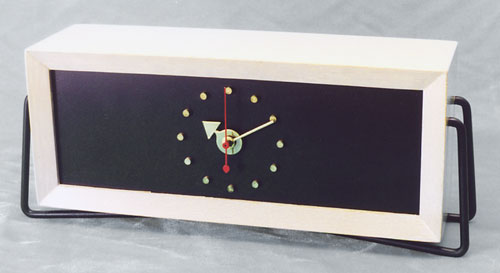 Another version was sold in a white wood-grain box
with a black front. The two support rods are black. Gold colored cylinders
indicate the hours. The hour and minute hands are gold colored and the second
hand is red. The guarantee sheet that came with it says Jefferson Electric Co.,
Zeeland, Michigan. The date on this clock is November 1956.
Another version was sold in a white wood-grain box
with a black front. The two support rods are black. Gold colored cylinders
indicate the hours. The hour and minute hands are gold colored and the second
hand is red. The guarantee sheet that came with it says Jefferson Electric Co.,
Zeeland, Michigan. The date on this clock is November 1956.
The address on the carton reads Jefferson Electric Co. Bellwood, Illinois. The carton size is 7-1/2" high, 16-1/4" wide and 5-1/4" deep. Thanks to Roger Zimmermann and Dan Schoo (Dan's Cockatoo Ranch) for pictures of the white clock and carton that is part of Rogerís collection.
The white version was advertised in the December 8, 1956 issue of The New Yorker magazine. The ad appeared on page 124 and showed a black and white picture.
The ad states: "The Contemporaire--so new, so beautiful--in mahogany, ebony or limed oak, with solid brass trim....$27.95." At that time, the Golden Hour was selling for $24.95 and the Golden Secret was selling for $22.95. The ebony version has a dial face that is bronze colored with black plastic cylinders to indicate the hours. Although the ad implies that the rods are solid brass, I found for the two models I have that the rods are attracted by a magnet and are therefore only plated steel.
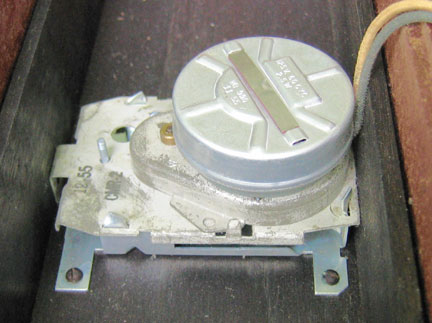
The motor and gear box are shown above. The date on the motor is 11-55 and the date on the main frame is 12-55. It is rated at 125V, 60 CYC, 2.5W and is UL approved.
Connection with George Nelson?
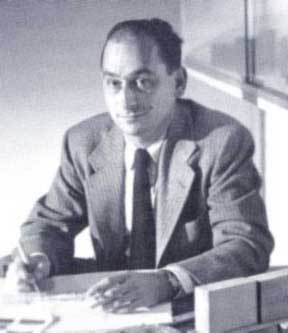 Zeeland, Michigan is
where the Herman Miller Furniture
Company is located. In 1946, George Nelson (left) became Director of Design
for Herman Miller, managing corporate designs for product/graphics, etc., as
well as producing his own acclaimed furniture pieces.
Zeeland, Michigan is
where the Herman Miller Furniture
Company is located. In 1946, George Nelson (left) became Director of Design
for Herman Miller, managing corporate designs for product/graphics, etc., as
well as producing his own acclaimed furniture pieces.
He was never an employee, but rather an independent designer who served in a corporate capacity. As a result, he was always free to pursue outside work, which led to his later collaboration with Howard Miller on the ball clock and other timepieces.
Nelson had been well known as an architect, editor, graphic designer, author, teacher, interior planner and industrial designer. He graduated from Yale College in 1928 and the School of Fine Arts in 1931. He became co-managing editor of Architectural Forum in 1943. He was associated with Herman Miller until 1972 and was a consultant after that. He died in 1986.
The Herman Miller Clock Company is also located in Zeeland, Michigan. It was an outgrowth of the Herman Miller Furniture Company. In the 1930's, it became the Howard Miller Clock Company when Herman Miller's son, Howard, took over, but today there is no formal relationship between the two companies. Originally, it made clocks in traditional designs but later changed to art deco styles. In the mid 1940's Nelson offered several modern clock designs to Howard Miller including the well known Ball Clock, which is a very collectable item today.
It may be that Jefferson Electric was one of Nelson's many clients for modern designs. It's possible he could have been the designer of the Contemporaire. However, a book was written about Nelson titled George Nelson: The Design of Modern Design by Stanley Abercrombe, published by the MIT Press, Cambridge, Mass 1995, ISBN 0-262-01142-5. It states on the book jacket "Abercrombe was given access to Nelson's office archives and personal papers. He also interviewed 70 of Nelson's friends, colleagues, employees and clients (including the late D. J. De Pree, former head of of the Herman Miller Furniture Company and Nelson's chief patron) and obtained many previously unpublished images from corporate and private archives". The appendixes in the book, compiled by Judith Nasatir, show a chronology of hundreds of clients and projects, from 1932 to 1984. There is no mention of Jefferson Electric ever being a client of George Nelson.
The wooden Contemporaire, with it's 1950's appearance and paste-on Jefferson label on the back with a Zeeland, MI address, is unlike any of the other Jefferson clocks. It could have been designed by Nelson for Howard Miller but then not marketed by Miller.
|
|
|
Nelson had designed clocks for Howard Miller in 1956, the date found in a Contemporaire clock. The hands of the Contemporaire (left) are very close, if not exactly the same in appearance to a clock designed by Nelson for Howard Miller (right). The clock may have been available for purchase by Jefferson and shipped from Zeeland directly to dealers. This could explain why Jefferson Electric was not mentioned as a client of Nelson and yet has the typical appearance of his designs. Alternately, the clock could have been a copy of the Nelson designs. The Zeeland address for warranty appears to be where the clock was to be returned for repair and not to Jefferson in Bellwood, IL. It has been pointed out that the management of Jefferson may not have approved of investing such a large sum of money that might be charged by any well known designer to style any of their clocks.
|
About This Site |
||
|
|
More text and pictures about Jefferson will be added as my research continues. Any comments, corrections, or additions are welcome. |
|
|
|
|
Created
by Roger Russell |
